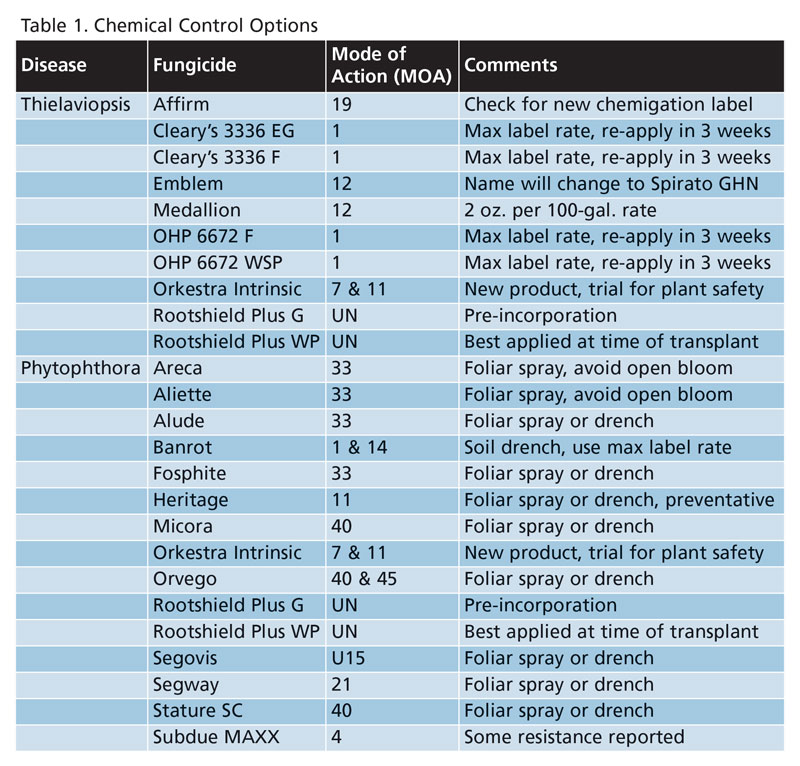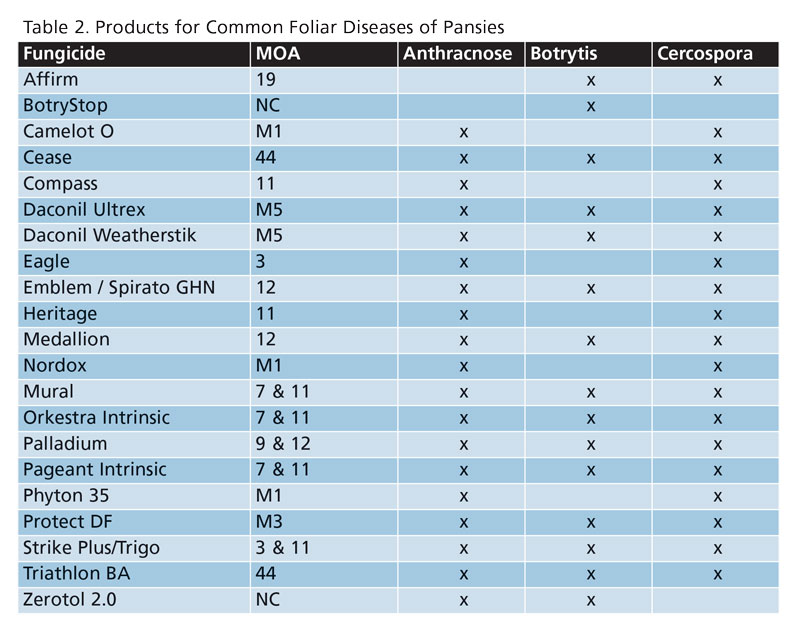7/1/2018
How to Defend Against Fall Pansy Diseases
Rick Yates

Few crops can compete with the performance of pansies and violas in the fall. For many regions, fall pansies are a landscape staple, providing impressive color through the autumn and winter months. In northern regions, pansies provide fresh fall color and can overwinter to provide an early burst of color in the spring. Breeders have ensured there’s a lot to enjoy: a myriad of colors, flower sizes and new plant habits. From the grower perspective, pansies also provide a welcome profit center that’s independent of spring.
Even with improved genetics, pansies are still a cool-season crop. Fall-flowering crops are typically started when the weather is quite warm, even hot, and therein lies the challenge from a disease-prevention standpoint. Two diseases of the root and crown can be particularly challenging for fall pansy production: Thielaviopsis and Phytophthora.
Thielaviopsis, also known as Black Root Rot, is a devigorating disease of pansies that’s inhibited to some extent at a soil pH below 5.8. Warning signs include roots that darken and are reluctant to grow out of the original plug. Infestations are often random in appearance with stunted pansies right alongside plants that are thriving. Unless you have a microscope and can identify Thielaviopsis spores in the roots, suspicious plants should be sent to a plant diagnostic lab for a positive identification.
Plants infected with Thielaviopsis cannot be salvaged, meaning fungicide treatments are used to protect adjacent healthy plants. Given the susceptibility of pansies and the environmental stresses early in production, we recommend a preventative drench soon after transplanting. The products we recommend for Thielaviopsis also control Rhizoctonia.
Phytophthora is seldom found in winter/spring-grown pansies, but can cause substantial losses in late summer and early fall. Warm temperatures and abundant splashing water favor this fast-moving disease. The zoospores (swimming stage) of Phytophthora can readily move about and enter healthy plants via the drain holes in pots and flats. For this reason, growing the crop up off the ground is very desirable. Benches are ideal; however, inverted flats or 1-in. PVC pipes under the flats will serve the purpose.
 Effective fungicides may be applied to address Phytophthora, but to be successful it’s important to reduce the risk for spread. Learning to identify the early symptoms, as well as the conditions that make disease expression more likely, is also key. Watch for sudden stem constriction and collapse at the crown. Rootshield Plus is a fungal-based preventative fungicide that includes Phytophthora prevention due to the addition of a second strain of Trichoderma to the original formulation. It’s also labeled for prevention of Thielaviopsis. (Chemical control options appear in Table 1.)
Effective fungicides may be applied to address Phytophthora, but to be successful it’s important to reduce the risk for spread. Learning to identify the early symptoms, as well as the conditions that make disease expression more likely, is also key. Watch for sudden stem constriction and collapse at the crown. Rootshield Plus is a fungal-based preventative fungicide that includes Phytophthora prevention due to the addition of a second strain of Trichoderma to the original formulation. It’s also labeled for prevention of Thielaviopsis. (Chemical control options appear in Table 1.)
Foliar diseases become more prevalent as the crop progresses and the weather cools. Anthracnose (Colletotrichum), Botrytis and Cercospora are among the troublemakers.
Anthracnose symptoms on pansies generally appear as large necrotic and chlorotic lesions that are somewhat irregularly shaped. Often, faint concentric rings can be detected within the necrotic tissue. Botrytis can be especially problematic, as early blooms begin to senesce and “melt,” sometimes involving adjacent foliage. Cercospora often manifests itself with dark purple spots, some of which have tan centers, giving rise to the “fish eye” description.
The corresponding tables contain fungicide suggestions to address root and crown diseases, as well as common foliar diseases.
Products for root and crown diseases
Apply as soil drenches except as noted. The current Affirm label forbids chemigation, but a new label is coming soon; bulk tank application is needed for now. Always read and follow all label directions. Products other than those mentioned may also be safe and effective. Some pesticides may be restricted-use or unregistered in certain states. GT
Rick Yates is GGSPro Technical Support Manager for Griffin. He can be reached at ggsprotech@griffinmail.com.